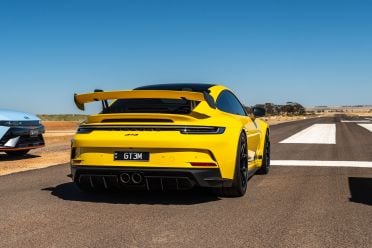25 years ago I learnt how to drive in a Hyundai Excel. I remember thinking at the time it was nothing more than an appliance to get from A-to-B. It wasn’t desirable, but it got the job done.
Fast forward 25 years and you’re now reading an article and watching a video featuring a Hyundai drag racing a Lamborghini that looks like it’s about to set off into space, and a Ferrari that’ll drain your bank account of $1.5 million before you even talk about colours and stitching.
Yep, we wanted to see how quick the 2024 Hyundai Ioniq 5 is by putting it up against some of the craziest cars on the road.
There’s a more detailed story about how and why we’re doing this here, but for all intents and purposes, this drag race is all about pitting the fully electric Ioniq 5 N up against a six-cylinder car, an eight-cylinder car, a 10-cylinder car, and finally a fire-breathing 12-cylinder car.
Strap in and enjoy watching the Korean missile take on some of the world’s finest exotics (and a Brabus!).
The cars
Representing the six-cylinder camp is the 992 Porsche 911 GT3 (manual).
It has a price tag of $417,400 (before on-road costs). It’s powered by a naturally aspirated six-cylinder petrol engine that produces 375kW of power and 470Nm of torque.
This particular example features a six-speed manual transmission. It’s also very yellow.
Our V8 comes in the form of a car with six exhaust pipes! Yes, it has three exhaust pipes on each side.
It’s the Mercedes-AMG G63. It’s priced at $363,561 before on-road costs, but it’s not quite stock. It has a carbon Brabus body kit and a Stage 1 engine tune.
In stock form it cranks out 430kW of power and 850Nm of torque, its Stage 1 tune adds an exhaust system (explains the extra exhaust pipe on each side…) and extra power and torque.
It uses a twin-turbocharged 4.0-litre V8 engine and sounds absolutely incredible. It’s also mated to a nine-speed automatic transmission.
10 cylinders of fury comes from the epic Lamborghini Huracan STO. It’s rear-wheel drive and uses a naturally aspirated 5.2-litre V10 petrol engine producing 470kW of power and 565Nm of torque.
It’s mated to a seven-speed dual-clutch transmission and features not only a roof scoop, but a giant wing. You’ll need to fork out $607,920 before on-road costs and options.
Finally, the V12 in this group is the epic Ferrari 812 Competizione. It’s the go-fast version of the front-engined V12 Ferrari platform.
It uses a naturally aspirated 6.5-litre petrol V12, which is mated to a seven-speed dual-clutch transmission and makes 610kW of power and 692Nm of torque.
It also has a price tag of $1,035,768 before on-road costs and options (it genuinely looks like they just pressed a bunch of numbers after the 1 to land on that price!).
The challenger
Priced at $110,000 before on-road costs, the fully electric Hyundai Ioniq 5 N uses a dual-motor all-wheel drive powertrain producing 448kW of power and 740Nm of torque, with those outputs increased to 478kW and 770Nm with the N Grin Boost function (which can be mated to the launch control function as well).
It has a claimed 0-100km/h time of 3.4 seconds with the N Grin Boost function active. It also has a bunch of other functions like the ability to destroy tyres, make engine sounds, and even pulse fictional gear shifts to make it feel like an internal-combustion car.
The results
We went into this content series thinking that it would be highly unlikely the Hyundai would be able to keep up with most of these cars.
What we didn’t count on was the laser-sharp repeatability. We had two Ioniq 5 Ns at the event (a spare one was there just in case we scored a stone chip on the windscreen or scored a puncture) but didn’t end up using the second car.
So over the week we were filming this set of videos, it ended up performing about 30 launch controls per day over four days, and each run was the exact same as the last. The repeatability was incredible.
All the internal combustion cars (more so with the rear-wheel drive ones and the faster all-wheel drive ones) needed time for warm up runs and took several attempts to launch before successfully hooking up.
That’s partly due to the surface, but also partly due to the infinite step changes available with an electric motor on launch in comparison to an internal combustion car.
Anyway, here are the results! The table is sortable, so have fun with it.
| Car | 0-100km/h | 80-120km/h | 1/4 mile |
|---|---|---|---|
| Hyundai Ioniq 5 N | 3.52 | 1.86 | 11.32 @ 195.92km/h |
| 992 Porsche 911 GT3 | 4.39 | 2.28 | 12.06 @ 194.72km/h |
| Lamborghini Huracan STO | 3.78 | 1.65 | 11.29 @ 209.34km/h |
| Mercedes-AMG G63 Brabus | 4.51 | 2.75 | 12.59 @ 176.85km/h |
| Ferrari 812 Competizione | 3.79 | 1.57 | 10.99 @ 220.33km/h |
We have more of these videos coming in the series, so make sure you’ve subscribed to the CarExpert YouTube channel to be notified each one of them goes live. There’s some absolute bonkers cars in the line up coming!











